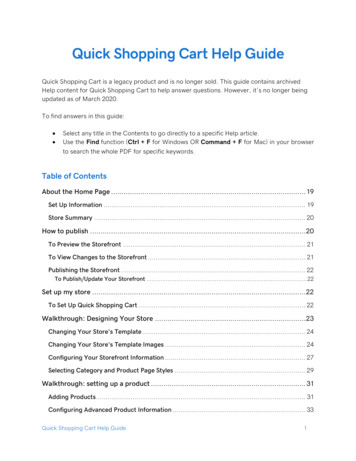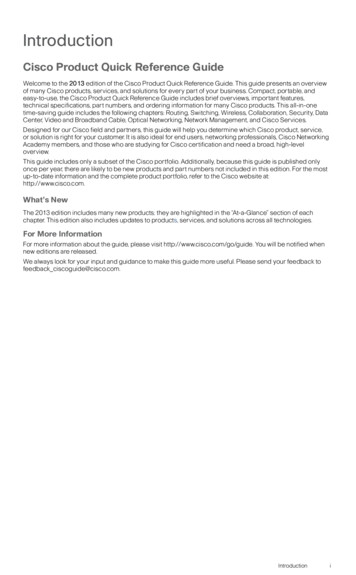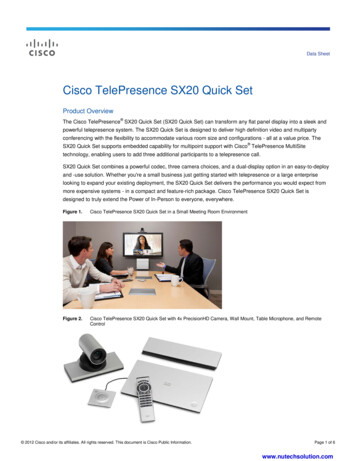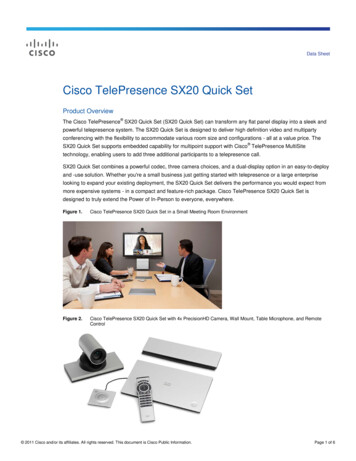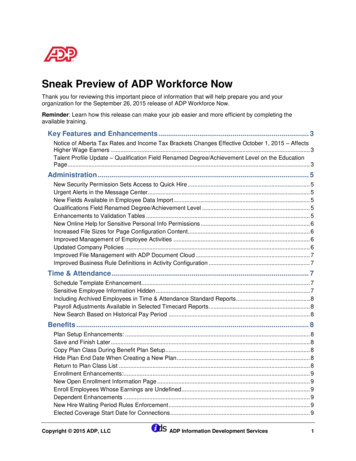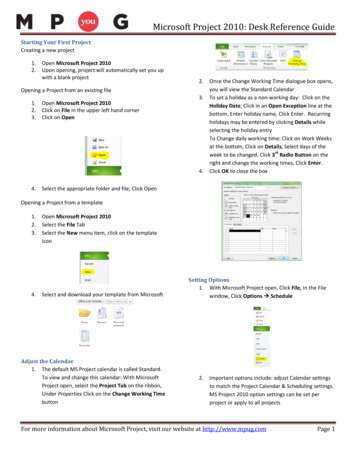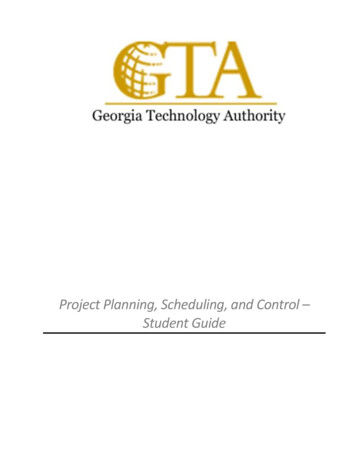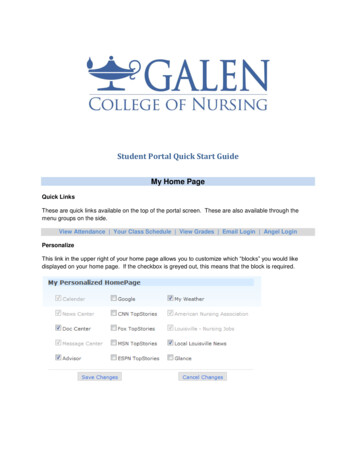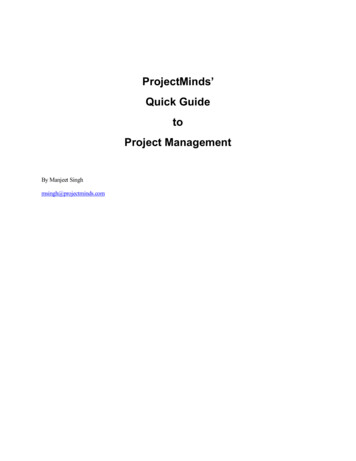
Transcription
ProjectMinds’Quick GuidetoProject ManagementBy Manjeet Singhmsingh@projectminds.com
AD IFFE RE NTK INDO FCO PYR IGHTNo rights reserved.All the parts of this book can be reproduced, stored in a retrieval system, or transmitted in any form or by any means,electronic, mechanical, photocopying, recording, scanning, or otherwise. You do not need the prior written permissionor authorization of the author.DIS CLA IME RThe author of this book specifically disclaims all responsibility for any liability, loss or risk to any person or entityarising from the use of information contained in this book or its Word file.V1.31
Table of ContentsIntroduction.1About the author. 1Chapter 1: Defining what aproject is.2Project success criteria . 2Why are organizations using projectmanagement?. 3Chapter 2: The project lifecycle 4Initiating . 4Planning . 4Executing: . 4Controlling and monitoring. 5Closing: . 5Chapter 3: Project initiatingprocess.6The SOW (Statement of Work). 6Chapter 4: Project planningprocess.8The WBS. 8Network diagrams . 10The Gantt chart. 10Getting and estimating resourcerequirements. 11People first . 11Nonperson resources . 12Creating your project plan. 13Chapter 5: Project executingprocess . 14Managing & leading .14Ensuring your team works well .15Communicating.15Chapter 6: Project controllingand monitoring . 16Review meetings.16Resolving conflicts.17Resolving project problems .18Controlling change.19Chapter 7: Project closingprocess . 20The project evaluation report .20
P R O J E C T M I N D S ’Q U I C KG U I D ET OP R O J E C TM A N A G E M E N TIntroductionThe purpose of this book is to share what I have learned about project management over the years.Please feel free to use this book for your professional and personal use. All I ask is that you insert areference to me or the www.projectminds.com website. Also, please send me an email to let meknow how you are using this book. My email is msingh@projectminds.com.This book will be updated on a regular basis. If you would like to contribute, please contact me onthe email above.I wish you lots of success using this book!About the authorManjeet Singh has 17 years of experience acquired in a wide variety of industries with a focus onproject management in the High-Tech field. Manjeet has an Executive MBA from the HECManagement School. He also is the author of www.projectminds.com, a website dedicated to projectmanagement resources.To contact him, please send an email to msingh@projectminds.com.www.projectminds.com1/23
P R O J E C T M I N D S ’Q U I C KG U I D ET OP R O J E C TM A N A G E M E N TChapter 1: Defining what a project isYou have been handed a project by your organization. Your job now is to effectively manage theproject to completion. For your project to be successful, you need to understand what exactlyconstitutes a project, and which criteria are used to determine whether a project is successful or not.A project has the following characteristics: A start and end date: projects have dates that specify when project activities start and whenthey end. Resources: time, money, people and equipment, used by the project. For example, toproduce a brochure you will need a team (designers, copywriters, creative directors, etc.),equipment (computers, printers, paper, delivery trucks, etc.) and money to pay thesalaries/fees, buy equipment, and so on. An outcome: a project has a specific outcome such as new highway, a satellite, a new officebuilding, a new piece of software, and so on.Project success criteriaWhatever its size, a project’s success is based on three main criteria as shown by the followingtriangle:OutcomeTimeBudgetYour project will therefore be deemed successful if it: Delivers the outcome with an agreed upon quality. Does not overrun its end date. Remains within budget (cost of resources).Note however, that outcome, time and budget are interrelated, and during a project you may need todo trade-offs between them. For example, if you want to get something done more quickly, you mayhave to pump in more money into your project for additional resources.www.projectminds.com2/23
P R O J E C T M I N D S ’Q U I C KG U I D ET OP R O J E C TM A N A G E M E N TWhy are organizations using project management?Today’s highly competitive business environment forces organizations to make high-qualityproducts at a lower cost and in a shorter duration. Organizations therefore are increasingly usingproject management because it allows you to plan and organize resources to achieve a specifiedoutcome within a given timeframe. The techniques of project management also help you manage andanticipate risks in a structured manner. Surveys of organizations using project management haveshown that project management allows for better utilization of resources, shorter development times,reduced costs, interdepartmental cooperation that builds synergies across the organization, and abetter focus on results and quality.www.projectminds.com3/23
P R O J E C T M I N D S ’Q U I C KG U I D ET OP R O J E C TM A N A G E M E N TChapter 2: The project lifecycleA project lifecycle typically has the following processes as defined by the Project ManagementInstitute (PMI):This book assumes that your project has already been selected, and that a Project Charter has beenproduced. A Project Charter is generally a document that provides a short description of the projectand designates the Project Manager. Sometimes a commercial contract also leads to the initiation ofproject especially in firms specialized in providing professional/consulting services.InitiatingDuring the initiating process, you will refine the project goals, review the expectations of allstakeholders, and determine assumptions and risks in the project. You will also start project teamselection -- if the project team has been imposed, then you need to familiarize yourself with their skillset and understand their roles in the project. At the end of this phase you will produce a Statement ofWork (SOW), which is a document that provides a description of the services or products that needto be produced by the project.PlanningDuring the planning process, you will detail the project in terms of its outcome, team members’ rolesand responsibilities, schedules, resources, scope and costs. At the end of this phase, you will producea project management plan, which is a document that details how your project will be executed,monitored and controlled, and closed. Such a document also contains a refined project scope, and isused as the project baseline.Executing:During the executing process, you apply your project management plan. In other words you directyour team so that it performs the work to produce the deliverables as detailed in the plan. Theexecuting process also involves implementing approved changes and corrective actions.www.projectminds.com4/23
P R O J E C T M I N D S ’Q U I C KG U I D ET OP R O J E C TM A N A G E M E N TControlling and monitoringDuring the controlling and monitoring process, you supervise project activities to ensure that they donot deviate from the initial plan and scope. When this happens, you will use a change controlprocedure to approve and reject change requests, and update the project plan/scope accordingly. Thecontrolling and monitoring phase also involves getting approval and signoff for project deliverables.Closing:During the closing process, you formally accept the deliverables and shut down the project or itsphases. You will also review the project and its results with your team and other stakeholders of theproject. At the end of the project you will produce a formal project closure document, and a projectevaluation report.www.projectminds.com5/23
P R O J E C T M I N D S ’Q U I C KG U I D ET OP R O J E C TM A N A G E M E N TChapter 3: Project initiating processYour project has been selected, and you have been appointed as the Project Manager. You shouldnow use the Project Charter or commercial contract, to get the wheels spinning in motion. At theminimum your Project Charter should: Designate you as the Project Manager with the authority to use resources to bring the projectto completion -- this is formally done by the project sponsor/main stakeholders. Provide a short description of the result, outcome, product or services to be produced by theproject. Refer to the commercial contract as the basis for initiating the project (if there is such aformal contract).After having reviewed the Project Charter, do the following: Ask the Project Sponsor and main stakeholders to share with you any emails, letters,memos, project feasibility, meeting minutes, requirements or other documents related to theproject. If a similar kind of project has already been completed, get your hands on all thedocumentation that was produced for that particular project. Set up a meeting with theproject manager of that project to ask for advice.The SOW (Statement of Work)The next thing that you want to do is start working on your Statement of Work (SOW), a crucialdocument that you will constantly update and use as a baseline for your project. Depending on thesize and complexity of the project, and your knowledge about the subject matter, you will need toorganize meetings with the stakeholders in order to refine the SOW and get it approved. A wellthought out SOW generally contains the following sections:An Executive SummaryProvides a short overview on the purpose of the project, its background, its scope and sometimes ahigh-level project plan.ObjectivesDescribes the objectives of the project. The majority of project management literature recommendsSMART objectives that are: Specific: your objectives must be clear so that if someone reads them, he or she can interpretthem without ambiguity. Measurable: you should be able to measure whether you are meeting the objectives or not. Achievable: do not try to attempt more than you can. Realistic: do you have the resources to achieve your objective? Time-specific: specify when an objective will be attained (date).www.projectminds.com6/23
P R O J E C T M I N D S ’Q U I C KG U I D ET OP R O J E C TM A N A G E M E N TScopeDetails the scope that you identified in the Executive Summary of the SOW. In this section, describethe work that will be done. Also, if required, explain what will not be done – this is especially usefulto avoid confusion. Note that the Scope section is one of the most important sections of the SOW.Therefore, be very specific when writing it.DeliverablesA list of the deliverables to be produced by the project. Describe each deliverable in an unambiguousmanner that is understood by the team member responsible for it.Project assumptions and risksThere might be a number of unknown issues while you are planning your project. For such issuesyou need to make assumptions, which constitute a risk. Typical project risks are associated withtimeframes, and availability of resources (funding, project team members, supplies, etc). Detail theidentified risks in your project and include contingency plans for each riskStakeholdersA list of all the stakeholders identified so far in the project. You may also want to detail roles of eachstakeholder in this section.TIP: Get your SOW approved by the stakeholders. Once this is done, you will be readyto start planning.www.projectminds.com7/23
P R O J E C T M I N D S ’Q U I C KG U I D ET OP R O J E C TM A N A G E M E N TChapter 4: Project planning processYou have now gained more knowledge about your project. Working on the SOW helped you refine anumber of aspects of your project. You should now start project planning, which involves: Detailing the activities that make up your project – you will use the Work BreakdownStructure (WBS) to accomplish this. Creating a network diagram to determine the dependencies among the activities. Identifying the resources (people, equipment, facilities, etc.) you need for the project. Establishing a schedule for your project and refining its scope. Putting all of the information into a project management plan that will become the baselinedocument for your project. Remember to get the plan approved by the main stakeholders ofthe project.The WBSTo begin the project planning process, start working on the WBS, which is an effective tool thathelps you list all the tasks involved in your project. The WBS allows you to group all the tasks undermain activities ensuring that you have a clear overview of what you need to execute during theproject.A good way of developing your project’s WBS is by using the major milestones/deliverables thatyou identified in your SOW. Once the milestones have been identified, brainstorm with your projectteam to detail the tasks that you must accomplish in order to achieve the milestones. If you and yourteam are familiar with the project, a milestone approach will work very well. If this is not the case,then consider including in your workshops someone who may not be on your project team but haspreviously completed a similar project.Here is a simplified WBS for the design of a website:www.projectminds.com8/23
P R O J E C T M I N D S ’Q U I C KG U I D ET OP R O J E C TM A N
a project management plan, which is a document that details how your project will be executed, monitored and controlled, and closed. Such a document also contains a refined project scope, and is used as the project baseline. Executing: During the executing process, you apply your project management plan. In other words you direct your team so that it performs the work to produce the .File Size: 271KBPage Count: 23


